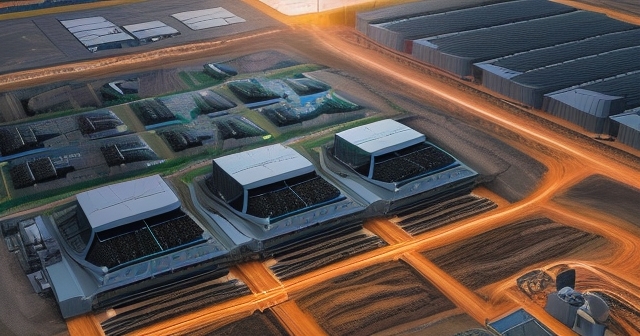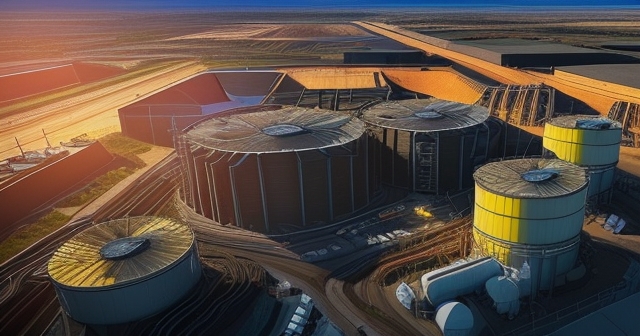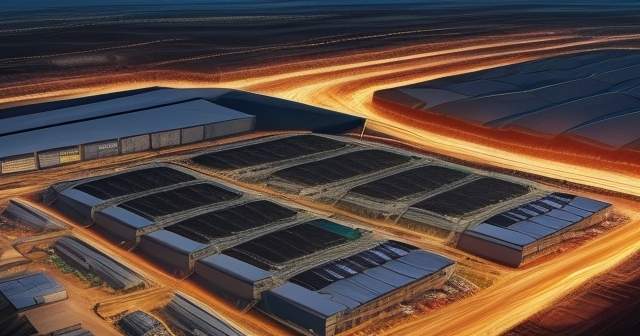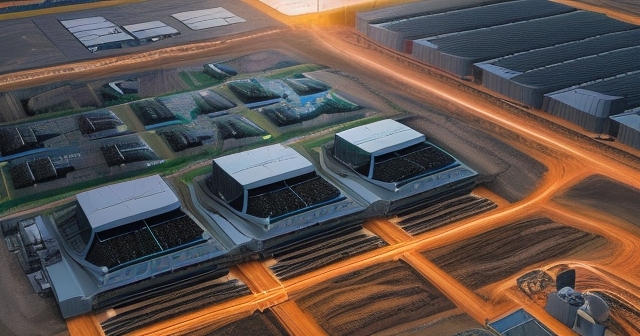CleanSpark: Navigating the Dynamic World of Bitcoin Mining with Strategic Growth and Energy Focus
Hello and welcome! As you venture into the exciting and often complex world of digital assets and strategic investments, understanding the infrastructure that powers this ecosystem is crucial. One area that has gained significant attention is Bitcoin mining – the process that validates transactions and creates new Bitcoin. Today, we’re going to take a deep, insightful look at a prominent player in this space: CleanSpark Inc. (NASDAQ: CLSK).
Perhaps you’ve heard the term “Bitcoin mining” or seen the ticker symbol CLSK appear in financial news. But what exactly does CleanSpark do? How do they operate in this energy-intensive sector, and what makes their approach stand out? More importantly, what should you, as an investor or aspiring trader, understand about their business model, growth strategy, and financial health? We aim to unpack all of this for you, providing the knowledge foundation you need to better understand this fascinating company.
Our goal isn’t just to present facts, but to help you connect the dots, much like putting together a complex puzzle. We’ll explore CleanSpark’s identity, their operational backbone, their unique energy strategy, and the ambitious steps they are taking to expand their footprint. By the end of this discussion, you should have a much clearer picture of CleanSpark and its position in the Bitcoin mining landscape.

At its heart, CleanSpark identifies itself proudly as “America’s Bitcoin Miner™”. This isn’t just a catchy slogan; it speaks to their focus on operating primarily within the United States and dedicating their resources almost exclusively to the complex computational task of mining Bitcoin. Unlike companies with diversified blockchain services or crypto exchanges, CleanSpark is a pure-play Bitcoin mining company. Think of them as digital prospectors, but instead of digging for gold, they are using specialized computer hardware to solve cryptographic puzzles.
- CleanSpark operates primarily in the U.S., focusing solely on Bitcoin mining.
- They utilize specialized hardware known as ASICs for mining.
- Their operational model emphasizes energy efficiency and sustainability.
What does this mining process entail? It requires massive computing power, measured in units like terahashes per second (TH/s) or, at CleanSpark’s scale, exahashes per second (EH/s). One exahash is an unfathomably large number – one quintillion hashes per second! These powerful machines, known as Application-Specific Integrated Circuits (ASICs), are housed in large facilities, often resembling data centers, where they run constantly, competing with other miners globally to be the first to validate a block of Bitcoin transactions. The winner of this computational race is rewarded with newly minted Bitcoin and transaction fees.
CleanSpark’s business model is fundamentally tied to its ability to acquire, deploy, and efficiently operate these mining machines within its infrastructure. Their success hinges on several factors: the efficiency of their mining hardware, the cost and reliability of their energy sources, the scale of their operations (total hashrate), and their ability to manage capital and navigate market cycles, particularly the Bitcoin halving events that periodically reduce the mining reward.
Their operational foundation is built upon developing and managing mining facilities that can host tens of thousands, sometimes hundreds of thousands, of these high-performance computers. These facilities require significant electrical capacity, cooling systems to manage the heat generated by the machines, and robust network connectivity. It’s a capital-intensive business, demanding continuous investment in both infrastructure and the latest generation of mining hardware to remain competitive.

One of the most significant discussions surrounding Bitcoin mining, and digital asset infrastructure in general, concerns its energy consumption. CleanSpark has proactively addressed this by making a commitment to sourcing low-carbon energy and supporting sustainable energy infrastructure. This isn’t merely a corporate social responsibility initiative; it’s a strategic business decision in an industry facing increasing scrutiny over its environmental footprint.
Their approach involves strategically locating their mining facilities in regions with access to energy sources that are carbon-neutral or have a significantly lower carbon intensity compared to traditional fossil fuels. This includes utilizing power derived from wind, solar, nuclear, and hydro power. Furthermore, CleanSpark actively seeks out opportunities to purchase renewable energy credits (RECs) to offset any carbon emissions associated with their energy consumption, further demonstrating their commitment.

Why is this energy strategy so important? From a business perspective, it can offer several advantages. Firstly, energy costs are typically the largest operational expense for a Bitcoin miner. Accessing low-cost, abundant renewable energy can significantly improve profitability. Secondly, a focus on sustainability can enhance the company’s reputation and appeal to environmentally conscious investors. It positions CleanSpark as a responsible participant in the digital asset ecosystem, potentially mitigating regulatory or public relations risks associated with high energy usage.
Think of it this way: imagine you run a factory that needs a lot of power. Finding a reliable source of cheap, clean energy isn’t just good for the environment; it’s smart business. CleanSpark applies this principle to their “digital factories” – their mining facilities. Their stated mission aligns the growth of Bitcoin mining with the growth of sustainable energy infrastructure, suggesting that the demand created by mining can actually incentivize investment in renewable power projects, particularly in areas with stranded or underutilized renewable energy potential.
Their operational sites, such as those in Georgia, have demonstrated this focus, aiming for high percentages of low-carbon energy usage. This energy strategy is a core pillar of CleanSpark’s identity and operational model, setting them apart in a competitive industry.
How does a company like CleanSpark scale its operations rapidly in a capital-intensive industry? While building new facilities from the ground up is one path, CleanSpark has aggressively pursued another: strategic acquisitions. Acquiring existing mining facilities or shovel-ready sites significantly accelerates their growth trajectory compared to organic build-outs, which can be time-consuming due to permitting, construction, and infrastructure development.

This strategy involves identifying promising locations with access to low-cost power and existing or easily upgradeable infrastructure. By purchasing these assets, CleanSpark can quickly add operational capacity (measured in Megawatts, or MW) and deploy mining machines, thereby boosting their total hashrate (EH/s). It’s akin to a retail chain acquiring smaller competitor stores to instantly gain market share and physical presence in new locations.
Their acquisition strategy has been a defining feature of their recent corporate actions. They’ve actively sought out and successfully acquired facilities across various states, demonstrating a clear intent to build a geographically diverse and robust mining footprint within the United States. This approach allows them to capitalize on different regional energy markets and regulatory environments.
| State | Acquisition Details | Impact on Hasrate |
|---|---|---|
| Georgia | Significant expansions in mining capacity | Boosts operational capacity |
| Mississippi | Large site acquisition for power capacity | Increases total hashrate |
| Tennessee | Acquisition of five mining facilities | Substantial operational capacity gain |
Why is speed important in this industry? The Bitcoin network’s total hashrate is constantly growing as more miners join. To maintain or increase their share of the block rewards, individual miners must also increase their hashrate. Acquisitions provide a fast-track way to achieve this scale, allowing CleanSpark to remain competitive and capture a larger piece of the mining rewards pie.
Furthermore, acquiring existing facilities can sometimes be more cost-effective than building new ones, especially if the acquired infrastructure is modern and well-maintained. It allows CleanSpark to deploy capital efficiently and start mining sooner, generating revenue faster than if they had to wait for new construction to be completed.
CleanSpark’s commitment to growth through acquisition is clearly visible in their recent activities. They haven’t just acquired one site; they have been strategically expanding across multiple states, solidifying their position as a major U.S.-based miner. Let’s look at some key examples that illustrate the scale and impact of this strategy:
Each of these acquisitions represents more than just buying property and equipment. They involve integrating new operational teams, adapting to local energy grids and regulations, and efficiently deploying the latest generation of mining hardware, such as Bitmain S21 miners, which are known for their energy efficiency and high hashrate output. These machines are crucial for maximizing Bitcoin production relative to power consumption.

These expansions demonstrate a clear, aggressive strategy to become one of the largest Bitcoin miners in the United States, measured both by operational capacity (MW) and computing power (EH/s). The pace of these acquisitions highlights CleanSpark’s ambition and ability to execute large-scale transactions in the market.
In the Bitcoin mining world, success and scale are primarily measured by two interconnected metrics: operational capacity in Megawatts (MW) and hashrate in Exahashes per Second (EH/s). Understanding these metrics is essential for evaluating a mining company’s performance and growth potential.
Megawatts (MW) represent the maximum amount of electrical power a facility can draw to operate its mining equipment. It’s the infrastructure’s capacity – how much “fuel” it can handle. A higher MW capacity means a facility can potentially host more mining machines or more powerful, energy-intensive machines.
Hashrate (EH/s), on the other hand, measures the total computational power of all the mining machines currently operating. It’s the “engine speed” – how quickly the company can perform the calculations needed to mine Bitcoin. A higher total hashrate means a miner is performing more computational work and thus has a higher probability of solving a block and earning Bitcoin rewards.
| Metric | Description | Importance |
|---|---|---|
| Operational Capacity (MW) | Power available for mining operations | Determines number of machines |
| Hashrate (EH/s) | Total computational power | Higher probability of mining blocks |
CleanSpark regularly reports on its progress in increasing both these metrics. Recent reports have indicated significant milestones, such as exceeding 14 EH/s, then 15 EH/s, and more recently surpassing 17 EH/s in operational hashrate. These numbers aren’t arbitrary; they represent substantial increases in computing power, directly resulting from deploying new machines and bringing acquired facilities online.
Think of MW as the size of the factory floor and the available power outlets, and EH/s as the number and speed of the machines on that floor working to produce something (Bitcoin). CleanSpark’s aggressive acquisition and deployment strategy directly translates into rapid increases in both MW capacity and operational EH/s. Monitoring these metrics through the company’s monthly production updates provides direct insight into their operational growth and execution capabilities.
As an investor, paying attention to these numbers is vital. They provide tangible evidence of the company’s expansion efforts and its potential to increase Bitcoin production, which is a key driver of revenue.
Beyond operational metrics, a company’s financial performance provides critical insights into its health, efficiency, and profitability. CleanSpark has recently reported strong financial results, signaling a period of robust performance, particularly following the Bitcoin halving event which occurred in April 2024.

Their financial reports, such as the results for Q1 and Q2 of Fiscal Year 2024 (FY2024), have highlighted significant achievements. Notably, the company reported record-breaking performance in Q2 FY2024. This included achieving a high Net Income figure, demonstrating strong profitability during the reporting period. For context, they reported a net income of $126.7 million in Q2 FY2024, a substantial increase from previous periods.
What drives these strong financial results? Several factors contribute. Increased operational hashrate means they are mining more Bitcoin. Efficient operations and access to low-cost energy minimize expenses. Furthermore, the price of Bitcoin itself plays a crucial role, as it directly impacts the value of the Bitcoin mined. The period leading up to and following the halving saw significant price movements in Bitcoin, which would naturally affect the revenue generated from mining.
Analyzing financial statements like the income statement, balance sheet, and cash flow statement provides a deeper understanding. Key line items to look for include revenue (driven by Bitcoin production and price), cost of revenue (primarily energy costs), operating expenses, and ultimately, net income or loss. CleanSpark’s recent reports suggest effective cost management and successful scaling have translated into strong bottom-line performance.
For you, as an investor, these financial reports offer a window into how well the company is executing its strategy and managing its resources. Record-breaking performance in Q2 FY2024 indicates that their investments in expansion and efficiency are yielding positive results, reinforcing the viability of their business model in the current market environment.
A key aspect of any growing company’s strategy is how it manages its capital and finances its expansion. Historically, some Bitcoin miners pursued a strategy of holding onto nearly all the Bitcoin they mined, accumulating large digital asset treasuries. While this strategy allows companies to benefit directly from Bitcoin’s price appreciation, it can also be restrictive, requiring external funding (either debt or equity) to cover operational costs and finance growth.
CleanSpark has shown an evolution in its capital strategy, particularly regarding its Bitcoin treasury management. While they still maintain a significant holding of Bitcoin (recently reporting over 12,000 BTC, valued at approximately $1 billion based on a BTC price of $84,500), they have shifted away from a near 100% hold strategy.
Their current approach involves selling a portion of their monthly Bitcoin production. This decision serves a crucial purpose: to cover operational expenses and fund ongoing growth initiatives. By selling enough Bitcoin to meet these needs, CleanSpark aims for operational self-sufficiency. This allows them to finance expansion, acquire new machines, and fund acquisitions without solely relying on issuing new shares (which dilutes existing shareholders) or taking on potentially burdensome debt solely for day-to-day operations.
This shift is a strategic move towards non-dilutive funding for their growth. While they do utilize debt – notably expanding their credit facility, such as the $200 million facility with Coinbase Prime – this debt is primarily aimed at financing accretive growth opportunities like large-scale acquisitions or machine purchases, rather than funding basic operational costs. Accessing significant credit facilities like the one with Coinbase Prime demonstrates the company’s access to institutional capital and its ability to leverage favorable financing terms.
Consider it like running a business where your primary product is also a valuable asset. Instead of selling nothing and needing loans for everything, you decide to sell just enough of your product each month to keep the lights on and buy new equipment, while still keeping a significant inventory of your valuable product for future potential appreciation. This is the essence of CleanSpark’s evolving treasury strategy.
This prudent approach to capital management, combining strategic Bitcoin sales with access to significant credit facilities, positions CleanSpark to fund its aggressive expansion plans efficiently while minimizing reliance on potentially dilutive equity financing in certain market conditions.
CleanSpark isn’t resting on its laurels. The company has set forth ambitious goals that underscore its vision for future growth and market positioning. A key target they have publicly communicated is reaching a total operational hashrate of 50 EH/s. This represents a significant leap from their current levels (surpassing 17 EH/s), requiring substantial continued investment and execution.
Achieving this 50 EH/s target involves a multi-pronged strategy. It necessitates continued investment in the latest, most efficient mining hardware, such as deploying more Bitmain S21 miners across their existing and newly acquired facilities. It also relies heavily on successfully closing and integrating planned acquisitions, like the GRIID facilities in Tennessee, and potentially identifying and acquiring further sites.
The company’s vision extends beyond just raw hashrate numbers. It includes optimizing the performance of their existing sites, ensuring high uptime and energy efficiency. It involves exploring new regions for expansion that offer favorable energy costs and regulatory environments. Furthermore, their continued commitment to low-carbon energy sources is likely to remain a central part of their expansion strategy, aligning growth with sustainability goals.
Setting such ambitious targets provides investors with a clear benchmark for evaluating the company’s progress. Each announcement of a new acquisition, a facility coming online, or a shipment of new machines deployed directly contributes to reaching these EH/s goals. Tracking these milestones is crucial for assessing the company’s execution against its stated objectives.
What does reaching 50 EH/s mean in practical terms? It means CleanSpark would command a much larger share of the total Bitcoin network hashrate, increasing their probability of mining blocks and thus significantly boosting their potential Bitcoin production. This scale is critical for long-term competitiveness, especially as the network hashrate continues to grow globally.
Their strategic investments in new hardware and infrastructure today are building the foundation for reaching these future targets and solidifying their position as a leading force in the global Bitcoin mining industry.
Behind every successful company is a team of experienced leaders guiding its strategy and execution. For CleanSpark, the executive leadership plays a crucial role in navigating the complexities of the Bitcoin mining industry, managing rapid growth, and building trust with investors and stakeholders. EEAT principles emphasize the importance of the people behind the content or, in this case, the company.
Key individuals, such as CEO Zach Bradford, are central to the company’s public image and strategic direction. Recent recognition, such as Zach Bradford receiving the Entrepreneur Of The Year 2024 Pacific Southwest Award from Ernst & Young LLP (EY US), highlights leadership excellence and contributes to the company’s perceived credibility and authority. Such awards acknowledge not just business success but often innovation, leadership, and commitment to building a strong organization.
The company’s executive team often includes seasoned professionals with backgrounds in finance, energy, technology, and operations. Appointments and roles such as Chief Operating Officer (COO) and Chief Technology Officer (CTO), as reported in their corporate updates, are critical for ensuring operational efficiency, technological advancement, and successful integration of acquired assets. For example, Brett Tejpaul and Barbara Domingo joined the Board, and Eleni Stylianou was appointed Chief Legal Officer, indicating strengthening of governance and legal expertise.
- CEO Zach Bradford emphasizes leadership integrity.
- Recognition awards enhance company credibility.
- Experienced professionals provide strategic oversight.
For you, as an investor, researching the management team is an important part of due diligence. Do they have relevant experience? Have they successfully guided companies through periods of growth or challenge? Their track record and public communications can provide valuable insights into the company’s culture, strategic discipline, and ability to execute.
CleanSpark’s leadership team’s visibility and recognition, combined with their clear articulation of the company’s strategy and performance through regular reports and public statements, contribute to the company’s authoritativeness and trustworthiness in the market. It demonstrates that there are experienced professionals steering the ship through the volatile waters of the digital asset space.
Operating in the Bitcoin mining industry presents both significant opportunities and unique challenges. Understanding this broader market context is essential for appreciating CleanSpark’s strategy and evaluating its future prospects.
The primary opportunity lies in the continued adoption and potential price appreciation of Bitcoin. As long as Bitcoin remains a valuable and actively used digital asset, the demand for mining to secure the network and process transactions will persist. Miners like CleanSpark are positioned to benefit directly from this by earning Bitcoin rewards.
Furthermore, the increasing focus on energy sustainability can be an opportunity for miners like CleanSpark who are actively pursuing low-carbon energy sources. This could attract investment, potentially lead to favorable energy contracts, and differentiate them from less environmentally conscious competitors.
However, the industry also faces significant challenges. The most prominent is the Bitcoin halving, which occurs approximately every four years and cuts the block reward for miners in half. The most recent halving in April 2024 significantly reduced the amount of new Bitcoin miners receive. This event tests the profitability of mining operations, particularly those with high energy costs or inefficient hardware. Miners must become more efficient and scale up to maintain profitability.
Energy price volatility is another major challenge. As energy is the largest operational cost, fluctuations in electricity rates can significantly impact margins. Regulatory uncertainty in various jurisdictions also poses a risk, as governments grapple with how to regulate digital assets and mining operations.
The increasing total network hashrate means competition is intensifying globally. To remain competitive, miners must continuously invest in the latest generation hardware, which is expensive. Market cycles in Bitcoin’s price introduce revenue volatility; miners must manage their balance sheets and capital strategy to weather potential downturns.
CleanSpark’s strategy of aggressive expansion, focus on energy efficiency and low-carbon sources, and evolving capital management (including strategic selling) are all direct responses to these market dynamics. Their aim is to build a large-scale, efficient, and financially resilient operation that can thrive despite the inherent challenges and capitalize on the long-term opportunities presented by the Bitcoin network.
As we’ve explored, CleanSpark Inc. is a dynamic and rapidly growing player in the U.S. Bitcoin mining sector. Identifying itself as “America’s Bitcoin Miner™”, the company has carved out a strategy focused on aggressive expansion through strategic acquisitions, a commitment to utilizing low-carbon energy sources, and an evolving, prudent capital management approach.
We’ve seen how their acquisitions in states like Georgia, Wyoming, Mississippi, and the planned acquisition in Tennessee are significantly increasing their operational capacity (MW) and driving their total hashrate (EH/s) towards ambitious targets like 50 EH/s. These expansions are fueled by investments in the latest mining hardware and access to substantial credit facilities like the $200 million line with Coinbase Prime.
Their recent financial results, including record-breaking net income in Q2 FY2024, demonstrate strong performance and operational efficiency, particularly important in the post-halving environment. The strategic shift to selling a portion of monthly Bitcoin production underscores a move towards operational self-sufficiency and non-dilutive funding for growth.
Led by figures like CEO Zach Bradford, the company emphasizes its expertise and operational excellence. While the Bitcoin mining industry faces inherent challenges, such as halving events, energy volatility, and increasing competition, CleanSpark’s strategic pillars – scale through acquisition, energy sustainability, and disciplined capital management – position it to navigate these complexities.
For you, whether a beginner investor or a trader refining your understanding, CleanSpark offers a compelling case study in a high-growth, high-tech industry. By focusing on the fundamentals we’ve discussed – operational scale, energy strategy, financial health, and capital management – you can gain a clearer perspective on the company’s potential and the factors likely to influence its future performance. Understanding these elements is key to making informed decisions in the fascinating world of digital asset infrastructure.
what is cleansparkFAQ
Q:What is CleanSpark’s main focus?
A:CleanSpark focuses exclusively on Bitcoin mining in the United States.
Q:How does CleanSpark ensure sustainability in their operations?
A:They source low-carbon energy and utilize renewable energy credits to offset carbon emissions.
Q:What is CleanSpark’s recent financial performance like?
A:They reported record net income, demonstrating strong profitability and operational efficiency.

留言